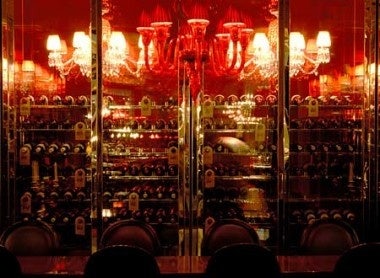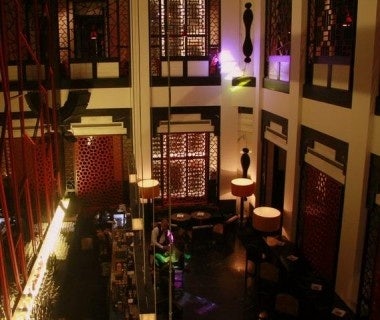High-End Chinese Restaurant Chain Currently Operates More Than 40 Locations In China#

If Chinese restaurateur Zhang Lan (South Beauty, LAN Club, SUBU) has her way, within a few years people around the world will reassess their conceptions of Chinese cuisine, associating it more with luxurious surroundings and a hefty bill than sweet, sticky globs of Kung Pao chicken. While it's easy to dismiss Zhang's dream of undoing more than 100 years of conditioning in such a short amount of time, it pays to bear in mind that she's managed to convince China's urban elite that their country's cuisine can occupy the same opulent surroundings as French or Japanese cuisine -- and that it's worth 5-10x the price of a typical "high-end" Chinese restaurant.
Since its establishment in 2000, Zhang's restaurant chain, South Beauty -- which operates under the motto, "Global Quality, Chinese Style" and specializes in Sichuan cuisine -- has grown from one location in Beijing's China World Trade Center to more than 40 locations throughout the country, powered mostly by Zhang Lan's intelligent yet aggressive style of branding. From a 2006 Forbes profile of Zhang:
[Zhang] is a Chinese celebrity restaurateur, emerging much in the way, say, Wolfgang Puck did in the U.S. She is renowned in Chinese gossip magazines for her impeccable dress sense and fondness for art. Zhang opened her first South Beauty in the basement of Beijing's China World Tower in 2000. It was a bold decision, given an untested concept and central-city rental prices. But with upstairs offices teeming with well-heeled lawyers and bankers--all hungry, it turned out, for South Beauty's mix of regional favorites served in a stylish environment--Zhang's gamble quickly paid off. Six years later South Beauty has a visible presence in China's first-tier cities, including a spot in Hong Kong's Causeway Bay.
"There is no other really successful national restaurant chain in this segment of the market, and they still have not occupied all the major Chinese cities," says Nathan Wang, an investment analyst in Hong Kong, who has kept an eye on the company.
As Zhang told CRI last year, her dream of spreading the gospel of high-end Chinese cuisine globally -- she envisions South Beauty as "China's Louis Vuitton" -- is well underway, as the company has been looking into overseas expansion for at least the last five years. But will "luxury Chinese food" sit well with westerners? While previous attempts at high-end Chinese cuisine, such as New York's Tao, have been somewhat successful, their food is rarely what can be considered authentic. However, Zhang Lan's penchant for flashy international design (her LAN Club was designed by Philippe Starck at a reported cost of nearly $2 million) and focus on providing safe -- a serious selling point after recent food scandals in China -- authentic Chinese cuisine in a world-class setting could prove more successful internationally than skeptics might think.
From a new 21st Century Business Herald article about Zhang Lan's dream of bringing upscale Chinese cuisine to the international masses (translation by Jing Daily team):
Unlike peers who want to become like today's McDonalds or KFC, Zhang Lan -- with her impressive cash reserves -- has the ability to chase even loftier dreams. With the successful deployment of her flagship high-end brand LAN Club and her fashion and lifestyle restaurant brand SUBU (designed by Danish architect Johanes Torpe -- JD), [Zhang Lan's] profit-making machine is trying to make a break from the competition, "going Ginza" on one side while making her brand something of a combination of Louis Vuitton and a Michelin Star restaurant on the other.
"Within the next two years, South Beauty will be in London, Zurich, Indonesia, and Moscow, among other places. We'll open 65 restaurants in 19 cities, [all with the aim of] letting the whole world learn more about and better understand China's food culture," Zhang Lan said.
Lexus vs. Toyota
At the end of 2004, [Zhang Lan's son] Wang Xiaofei returned to China, and his first responsibility was the "LAN Club." Two years later, with interior design completed by top French designer Philippe Starck at a reported fee of 12 million yuan (US$1.76 million) and a total investment of over 300 million yuan (US$44 million), LAN Club became one of Beijing's most talked-about topics. "A chair worth 180,000 yuan (US$26,350), a crystal chandelier worth more than 400,000 yuan (US$58,550)," this kind of talk challenged people's preconceptions about what a high-end restaurant could be.
"When I first joined [the South Beauty Group], the LAN Club was going to be South Beauty's flagship, but I wanted to go in a different direction. I insisted that we make a break from South Beauty's food and trademark style." As Zhang Lan's only son, Wang Xiaofei now acts as the executive director of South Beauty, and is responsible for two brands created by the South Beauty Group -- the LAN Club, an upscale luxury club aimed at high-level businesspeople, and SUBU, a conceptual high-end fashion and lifestyle restaurant aimed at a younger and hipper set.
Although Wang Xiaofei's ideas initially stirred up some controversy, he eventually won over the support of Zhang Lan.
"The way I see it is that the relationship between LAN Club and South Beauty should be kind of like the one between Toyota and Lexus," said the car nut Wang Xiaofei..."The workmanship and elements obviously differ, but the fundamental difference is the engine. The engine of a restaurant is its dishes."
To give LAN Club an engine to match its positioning, Wang Xiaofei pledged to Zhang Lan to create dishes in the spirit of the "four treasures" at South Beauty. To do this, Wang started to build a team, appointing himself director of R&D. Among Wang's group, aside from instructors from Sichuan, Guangdong, Beijing and other places, was an instructor of Western cuisine. He put everyone in charge of one department. [Finally, Wang] launched a completely new kind of cuisine at South Beauty: "Lan cuisine."
"This is our own type of cuisine. It's not a new style of Chinese food, nor is it an improvement on Sichuan cuisine. It's our own style, one that combines every type of Chinese cooking, while also incorporating the use of separate dishes and table arrangement we see in Western cuisine. Essentially, we use Western techniques to better package Chinese cuisine," Wang Xiaofei said. Currently, his "Lan cuisine" has already led to three new menus. On June 3, South Beauty's menu will be totally revamped, with all-new dish designs and plate arrangements, in order to call back to the Lan cuisine experience.
...
In addition to swapping out traditional jazz for a DJ, Wang Xiaofei will also cooperate with the Ullens Center for Contemporary Art (UCCA) to use the main banquet hall for regular art exhibitions -- "Not for selling, just for exhibition" -- in order to give time-strapped people with an interest in artwork the opportunity to appreciate it at their leisure before or after dinner with friends or business partners.
...
Everything Wang Xiaofei wants to do seems to extend far beyond Zhang Lan's wildest dreams for her restaurant. A split-level global flagship LAN Club at New York's 1 World Trade Center; a South Beauty brand hotel; perfume; clothing...This may help explain why the South Beauty Group is so different from its domestic counterparts and is a true "group" in the European luxury sense. "What we want to do with South Beauty is form a Chinese luxury brand, sort of like how a French luxury association is involved with every type of product imaginable," Wang Xiaofei explained.
Making dreams a reality
South Beauty's "driving force" is the hope of expanding into overseas markets. As Zhang Lan has said, her dream is to "change the prevailing view among non-Chinese that Chinese food is low-end." Just last year, she found a way to achieve this dream.
"We started looking for partners overseas," Zhang said.
South Beauty's first partner was Royal, a company listed in Japan. With more than 1,000 restaurants, and with a 70% hold on the in-flight catering business in Japan, what drew Zhang Lan to Royal was its "location resources." According to Zhang Lan's plan, both sides will gradually transform 51% of Royal locations into shared South Beauty locations, with Royal responsible for this investment, which will help South Beauty break into the Japanese mainstream restaurant market. The first Royal location chosen to pair with South Beauty will be in Japan's most popular shopping area, Omotesando in Tokyo.
...
"Looking to partners for access to overseas markets is the best way, because you're unfamiliar with the local laws and market, and a good partner can help you adapt quickly," Zhang Lan said, "There are many foreign companies that want to work with us, and we're negotiating and checking them out, and currently basing our choices on the financial position of the other party, and whether they've had any experience or have any reputation in the restaurant business. Presently, we've signed preliminary agreements in 65 countries."
...
Zhang Lan has enough capital to make overseas expansion possible, and for the last eight years has explored the process of standardization, working together with IBM on a standardization process for her restaurants. For example, at South Beauty all of the ingredients of a dish of fish-flavored pork are specified down to the last gram then the process is set by a central kitchen, even accounting for the daily cost of fresh materials. Currently, South Beauty's central Beijing kitchen has the production capacity to supply 100 restaurants.
In line with South Beauty's overseas expansion strategy, Zhang Lan began to establish a more globally focused management team. "We hope the entire team can be more international, to better understand local cultures. Managers from different countries will first be brought in to China to learn about South Beauty and Chinese cuisine, then will be sent abroad so they can incorporate these international nuances into South Beauty. We will also send our management staff to study abroad. Currently South Beauty has 6,000 employees, so depending on the staff's individual strengths in areas like conducting business, management skills, bilingualism or other areas we'll send them to universities in China and Singapore. We are also in discussions with Columbia University, and we hope we'll soon be able to send our best managers there to study."
Zhang Lan's hope is to bring together people from different places and different specialties to form a big family, to make South Beauty like "a family business that's not a family business."

